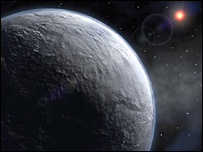
It seems we are not alone. Mankind might have other living things in the galaxy keeping us company. Indeed, a new planet has been discovered, which is just like our home, panet Earth!
How can we be sure about this? The newly discovered planet, Gliese 581 g, is 3 or 4 times larger than Earth. This means that the surface of the planet is solid, not liquid or gaseous.
The planet revolves around a star and is bang in the middle of that planetary system. This makes it the right distance from the star for the water on the planet to remain in a liquid state. Otherwise, it would have been frozen into solid ice or heated into steam.
In other words, the planet is in the "habitable zone", and that's all that is required to suggest that life may be present on the planet.
Other than that, the planetary system and its star are boring in every way that you can imagine. The star, named Gliese 581, is a common red dwarf, the most lowly type of star in the Milky Way.
It is about one third the size of our star, the Sun, and is about 20 light years away from us. So, if you were to shine a ray of light from Earth roughly in the direction of Libra, it would reach Gliese 581 in twenty years.
The planet looks ordinary, and you can't see it without a telescope. However, everyone in the scientific world is hopping with excitement. Just recently, it was discovered that a total of six planets are orbiting the star, making this one of the most exciting solar systems that we know of.
In fact, the presence of an Earth-like planet alone is enough to cause a buzz. Ever since the dawn of science, man has wondered whether there is any other Earth-like planet out in space. Now, it seems, we are very close to a definite answer.
However, does Earth's new "twin" also support life? That is the zillion-dollar question on everyone's lips.
Steve Vogt of the University of California says, "We're pretty excited about it... I think this is what everyone's been after for the past 15 years... this is right next door to us. That's the big result."
In a cluster of 116 stars, we now have two potentially life-friendly planets, including Earth itself. But there could be many more! After all, we have only carefully studied nine planets out of the 116. So what are the chances of another one coming up?
If there turns out to be a whole group of other habitable, life-friendly planets, just imagine if even one of them has life on it!



